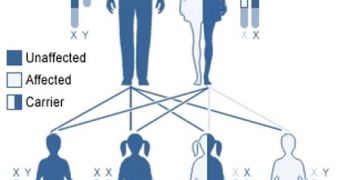Scientists were recently able to gain new insight into the genetic foundation of a dangerous and rare disease, that affects mostly children. One of the most common manifestations of this disease in kids is self-mutilation, and experts have been seeking to understand this behavior for years.
In all fairness, this inherited disease is transmitted genetically, and is very rare. It is called the Lesch-Nyhan Disease (LND), and it can generally be diagnosed within a child's first year of life, Science Blog reports.
At first, the symptoms include moderate mental retardation and poor muscle control, in addition to afflictions of the kidneys and severe gout. After the first year of life, these signs diversify, and grow to include self-mutilating behaviors such as lip- and finger-biting.
According to experts from the University of California in San Diego (UCSD) School of Medicine, who led the research, pathways involved in this condition may be at work in underlying other neurological disorders as well.
The team says that neurodegenerative disease and forms of dementia such as Alzheimer’s and Parkinson’s diseases may use two of the pathways that were recently found to be defective in LND.
Through the new research, the UCSD team was able to provide the international medical community with fresh insight into the reasons why children suffering from this inherited disease exhibit compulsive behavior and cognitive defects.
“This study is important because it opens completely new and unexpected areas of research into the genetic cause of compulsive and self-injurious behavior in Lesch-Nyhan disease,” says expert Theodore Friedmann, MD.
“We think that the findings also have implications for far more common diseases related to the central nervous system, such as Alzheimer’s and Parkinson’s diseases, since defects similar or related to those that we’ve found are also seen in other neurodegenerative diseases – suggesting common mechanisms for some of the cognitive, behavioral and neurological defects in all these disorders,” he adds.
Friedmann, the principal investigator on the new study, holds an appointment as a professor of pediatrics at the UCSD Center for Neural Circuit and Behavior. He is also based at the Rady Children’s Hospital-San Diego.
The full details and conclusions gathered from the new work appear in the January 28 issue of the open-access scientific journal PLoS ONE, which is a magazine edited by the Public Library of Science.

 14 DAY TRIAL //
14 DAY TRIAL //